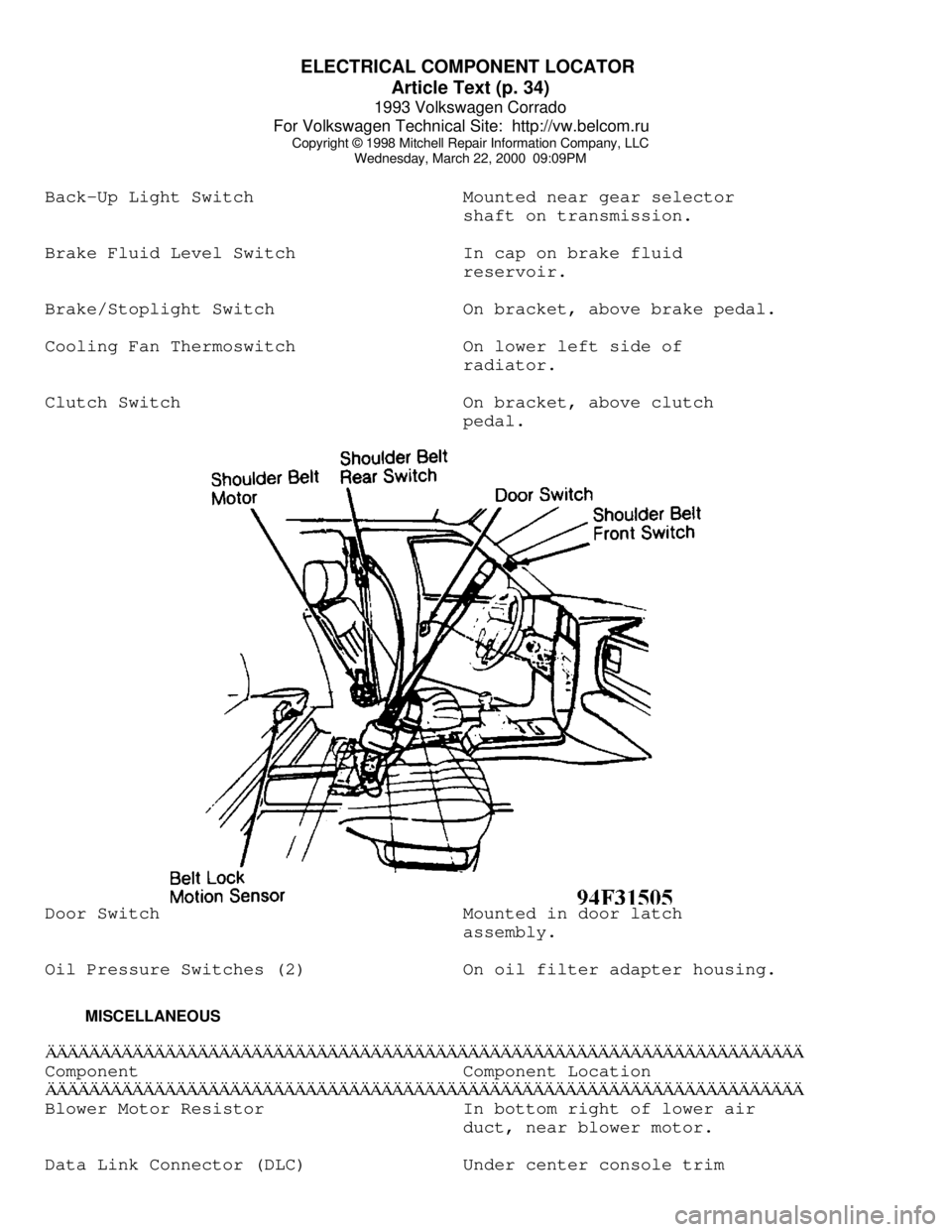1993 VOLKSWAGEN CORRADO technical data
[x] Cancel search: technical dataPage 369 of 920

A/C SYSTEM GENERAL SERVICING
Article Text
1993 Volkswagen Corrado
For Volkswagen Technical Site: http://vw.belcom.ru
Copyright © 1998 Mitchell Repair Information Company, LLC
Wednesday, March 22, 2000 08:48PM
ARTICLE BEGINNING
1993 GENERAL SERVICING
General Servicing Procedures
USING R-12 & R-134a REFRIGERANT
HANDLING/SAFETY PRECAUTIONS
1) Always work in a well-ventilated, clean area. Refrigerant
R-134a is colorless and is invisible as a gas. Refrigerant (R-12 or R-
134a) is heavier than oxygen and will displace oxygen in a confined
area. Avoid breathing refrigerant vapors. Exposure may irritate eyes,
nose and throat.
2) The system's high pressure can cause severe injury to eyes
and skin if a hose were to burst. Always wear eye protection when
working around A/C system and refrigerant. If necessary, wear rubber
gloves or other protective clothing.
3) Refrigerant evaporates quickly when exposed to atmosphere,
freezing anything it contacts. If liquid refrigerant contacts eyes or
skin, DO NOT rub eyes or skin. Immediately flush affected area with
cool water for 15 minutes and consult a doctor or hospital.
4) Never use R-134a in combination with compressed air for
leak testing. Pressurized R-134a in the presence of oxygen (air
concentrations greater than 60% by volume) may form a combustible
mixture. DO NOT introduce compressed air into R-134a containers (full
or empty), A/C system components or service equipment.
5) DO NOT expose A/C system components to high temperatures,
steam cleaning for example, as excessive heat will cause
refrigerant/system pressure to increase. Never expose refrigerant
directly to open flame. If refrigerant needs to be warmed, place
bottom of refrigerant tank in warm water. Water temperature MUST NOT
exceed 125øF (52øC).
6) Use care when handling refrigerant containers. DO NOT
drop, strike, puncture or incinerate containers. Use Department Of
Transportation (DOT) approved, DOT 4BW or DOT 4BA, refrigerant
containers.
7) Never overfill refrigerant containers. The safe filling
level of a refrigerant container MUST NOT exceed 60% of the
container's gross weight rating. Store refrigerant containers at
temperature less than 125
øF (52øC).
8) R-12 refrigerant (Freon) will be sold and stored in White
containers, while R-134a refrigerant will be sold and stored in 30 or
50-pound Light Blue containers.
9) R-12 and R-134a refrigerants must never be mixed, as their
desiccants and lubricants are not compatible. If the refrigerants are
mixed, system cross-contamination or A/C system component failure may
occur. Always use separate servicing and refrigerant
recovery/recycling equipment.
10) Follow equipment manufacturer instructions of all service
equipment to be used. The Material Safety Data Sheet (MSDS), provided
by refrigerant manufacturer/suppliers, contains valuable information
Page 451 of 920

COMPUTER RELEARN PROCEDURES
Article Text
1993 Volkswagen Corrado
For Volkswagen Technical Site: http://vw.belcom.ru
Copyright © 1998 Mitchell Repair Information Company, LLC
Wednesday, March 22, 2000 08:58PM
ARTICLE BEGINNING
GENERAL INFORMATION
Computer Relearn Procedures
All Models
* PLEASE READ THIS FIRST *
The following general procedures are to be used if
driveability problems are encountered after power loss or battery has
been disconnected. These procedures may provide an aid in eliminating
these problems.
To reduce the possibility of complaints, after any service
which requires battery power to be disconnected, vehicle should be
road tested.
COMPUTER RELEARN PROCEDURES
Vehicles equipped with engine or transmission computers may
require a relearn procedure after vehicle battery is disconnected.
Many vehicle computers memorize and store vehicle operation patterns
for optimum driveability and performance. When vehicle battery is
disconnected, this memory is lost. The computer will use default data
until new data from each key start is stored. As computer memorizes
vehicle operation for each new key start, driveability is restored.
Vehicle computers may memorize vehicles operation patterns for 40 of
more key starts.
Customers often complain of driveability problems during
relearn stage because vehicle acts differently then before being
serviced. Depending on type and make of vehicle and how it is
equipped, the following complaints (driveability problems) may exist:
* Harsh Or Poor Shift Quality
* Rough Or Unstable Idle
* Hesitation Or Stumble
* Rich Or Lean Running
* Poor Fuel Mileage
These symptoms and complaints should disappear after a number
of drive cycles have been memorized. To reduce the possibility of
complaints, after any service which requires battery power to be
disconnected, vehicle should be road tested. If a specific relearn
procedure is not available, the following procedure may be used:
Automatic Transmission
* Set parking brake, start engine in "P" or "N" position.
Warm-up vehicle to normal operating temperature or until
cooling fan cycles.
* Allow vehicle to idle for one minute in "N" position. Select
Page 492 of 920

ELECTRICAL COMPONENT LOCATOR
Article Text (p. 34)
1993 Volkswagen Corrado
For Volkswagen Technical Site: http://vw.belcom.ru
Copyright © 1998 Mitchell Repair Information Company, LLC
Wednesday, March 22, 2000 09:09PM
Back-Up Light Switch Mounted near gear selector
shaft on transmission.
Brake Fluid Level Switch In cap on brake fluid
reservoir.
Brake/Stoplight Switch On bracket, above brake pedal.
Cooling Fan Thermoswitch On lower left side of
radiator.
Clutch Switch On bracket, above clutch
pedal.Door Switch Mounted in door latch
assembly.
Oil Pressure Switches (2) On oil filter adapter housing.
MISCELLANEOUSÄÄÄÄÄÄÄÄÄÄÄÄÄÄÄÄÄÄÄÄÄÄÄÄÄÄÄÄÄÄÄÄÄÄÄÄÄÄÄÄÄÄÄÄÄÄÄÄÄÄÄÄÄÄÄÄÄÄÄÄÄÄÄÄÄÄÄÄÄÄComponent Component Location
ÄÄÄÄÄÄÄÄÄÄÄÄÄÄÄÄÄÄÄÄÄÄÄÄÄÄÄÄÄÄÄÄÄÄÄÄÄÄÄÄÄÄÄÄÄÄÄÄÄÄÄÄÄÄÄÄÄÄÄÄÄÄÄÄÄÄÄÄÄÄBlower Motor Resistor In bottom right of lower air
duct, near blower motor.
Data Link Connector (DLC) Under center console trim
Page 494 of 920

D - ADJUSTMENTS
Article Text
1993 Volkswagen Corrado
For Volkswagen Technical Site: http://vw.belcom.ru
Copyright © 1998 Mitchell Repair Information Company, LLC
Wednesday, March 22, 2000 08:59PM
ARTICLE BEGINNING
1993 ENGINE PERFORMANCE
On-Vehicle Adjustments
Corrado SLC
ENGINE MECHANICAL
Before performing any on-vehicle adjustments to fuel or
ignition systems, ensure engine mechanical condition is okay.
VALVE CLEARANCE
NOTE: All models use hydraulic lifters. No adjustments are
required.
IGNITION TIMING
NOTE: See ENTERING SELF-DIAGNOSTICS in the G - TESTS W/CODES
article in this section for additional scan tester
operating instructions.
VR6 IGNITION TIMING
1) Start and warm engine to normal operating temperature.
Ensure engine oil temperature is 176øF (80øC). Ensure A/C and
electrical loads are off, including cooling fan.
2) Connect engine analyzer to engine. Connect Scan Tester
(VAG 1551) to Data Link Connectors (DLC) located in center console, in
front of shift lever. Ensure no Diagnostic Trouble Codes (DTC) are
stored.
3) Ensure throttle position sensor is properly adjusted.
Ensure idle air control valve is okay. Valve must vibrate or hum.
Connect CO tester using Adapter (VAG 1363/3) on CO tap tube. DO NOT
remove oxygen sensor. Ensure exhaust system has no leaks.
4) Start engine and let it run at closed throttle (less than
1500 RPM). Operate scan tester and observe display. Press "1" button
to select RAPID DATA TRANSFER function. Press "Q" button to enter
input. Press right arrow button.
5) Press "0" and "1" buttons to select ENGINE ELECTRONICS
function. Press "Q" button to enter input. Press right arrow button,
then "0" and "4" buttons to select BASIC SETTING function. Press "Q"
button to enter input.
6) Press "0" and "1" buttons to select INPUT DISPLAY GROUP
NUMBER 01. Press "Q" button to enter input. Scan tester will display
SYSTEM IN BASIC ADJUSTMENT 1 through 4. Briefly increase engine speed
and then let it run for 2 minutes at closed throttle. Scan tester
displays idle speed in field one and ignition timing in field four.
Check CO level on CO tester.
7) When radiator cooling fan stops running, end basic setting
Page 495 of 920

D - ADJUSTMENTS
Article Text (p. 2)
1993 Volkswagen Corrado
For Volkswagen Technical Site: http://vw.belcom.ru
Copyright © 1998 Mitchell Repair Information Company, LLC
Wednesday, March 22, 2000 08:59PM
function by pressing right arrow button. Press "0" and "6" for END
OUTPUT function. Press "Q" button to enter input.
8) If idle speed, CO level or ignition timing is incorrect,
turn ignition off. Check accelerator pedal and throttle cable for ease
of operation. Check dashpot adjustment. Check throttle position
sensor, idle air control valve, and EGR valve.
IDLE SPEED & MIXTURE
NOTE: Mixture adjustment is NOT a part of normal tune-up procedure
and should not be performed unless mixture control unit is
replaced or vehicle fails emissions testing.
NOTE: Ensure fuel system pressure is correct before attempting
idle speed or mixture adjustment.
VR6 IDLE SPEED & MIXTURE ADJUSTMENT
See VR6 IGNITION TIMING under IGNITION TIMING near the
beginning of this article.
THROTTLE BODY
THROTTLE BODY ADJUSTMENT
CAUTION: Throttle limiting (stop) screw is set by manufacturer and
should NOT be moved. If screw is accidentally turned,
perform throttle body adjustment.
If stop screw for basic throttle adjustment has been moved,
replace throttle body.
DASHPOT
Open and close throttle until dashpot piston contacts roller.
With throttle in this position, check gap between limiter (stop) screw
and throttle. Gap between limiter (stop) screw and throttle lever must
be 0.10-0.14" (2.5-3.5 mm).
IDLE & FULL THROTTLE SWITCHES
THROTTLE POSITION (TP) SENSOR ADJUSTMENT
1) Connect Scan Tester (VAG 1551) to Data Link Connectors
(DLC) located in center console, in front of shift lever. Turn
ignition on. Operate scan tester and select RAPID DATA TRANSFER,
ENGINE ELECTRONICS, then READ MEASURING VALUE BLOCK functions.
2) Press "0" and "3" buttons to select INSERT DISPLAY GROUP
NUMBER 03 function. Press "Q" button to enter input. Slowly open
throttle, while observing display in channel 3, until throttle is wide
open. Numerical value must increase uniformly over entire opening
Page 502 of 920

DOOR LOCKS - POWER
Article Text (p. 4)
1993 Volkswagen Corrado
For Volkswagen Technical Site: http://vw.belcom.ru
Copyright © 1998 Mitchell Repair Information Company, LLC
Wednesday, March 22, 2000 09:08PM
VACUUM SYSTEM CHECK
Door Lock System Does Not Operate
Locate vacuum hose junction. See Fig. 1, 2 or 3. Individually
remove vacuum hose from junction box. Plug junction box port. If door
lock system operates, repair vacuum in hose. If door lock system does
not operate, repeat procedure for all other vacuum circuit at junction
box.
TESTING
SYSTEM TEST
Ensure vehicle battery is fully charged, fuses are okay and
no leaks are present in vacuum system. When activated, bi-pressure
should operate longer than 5 seconds and then pulse.
CONTROL MODULE TEST
Perform all procedures under TROUBLESHOOTING. If system still
does not perform correctly, replace control module.
REMOVAL & INSTALLATION
CAUTION: When battery is disconnected, vehicle computer and memory
systems may lose memory data. Driveability problems may
exist until computer systems have completed a relearn
cycle. See COMPUTER RELEARN PROCEDURES article in GENERAL
INFORMATION before disconnecting battery.
BI-PRESSURE PUMP
Removal & Installation
Remove right rear luggage trim. Remove bi-pressure pump
bracket and insulation. Remove bi-pressure pump. See Fig. 5. To
install, reverse removal procedure.Fig. 5: Locating Bi-Pressure Pump
(Corrado SLC Is Shown; Passat Is Similar)
Courtesy of Volkswagen United States, Inc.
Page 581 of 920

FUSES & CIRCUIT BREAKERS
Article Text (p. 3)
1993 Volkswagen Corrado
For Volkswagen Technical Site: http://vw.belcom.ru
Copyright © 1998 Mitchell Repair Information Company, LLC
Wednesday, March 22, 2000 09:11PM
start at any time even when the ignition key is in the OFF
position. DO NOT loosen or remove radiator cap when cooling
system is hot.
REPLACING BLOWN FUSES
Before replacing a blown fuse, remove ignition key, turn off
all lights and accessories to avoid damaging the electrical system. Be
sure to use fuse with the correct indicated amperage rating. The use
of an incorrect amperage rating fuse may result in a dangerous
electrical system overload.
BATTERY WARNING
WARNING: When battery is disconnected, vehicles equipped with
computers may lose memory data. When battery power is
restored, driveability problems may exist on some vehicles.
These vehicles may require a relearn procedure. See COMPUTER
RELEARN PROCEDURES article in GENERAL INFORMATION section.
BRAKE PAD WEAR INDICATOR
Indicator will cause a squealing or scraping noise, warning
that brake pads need replacement.
HALOGEN BULBS
Halogen bulbs contain pressurized gas which may explode if
overheated. DO NOT touch glass portion of bulb with bare hands. Eye
protection should be worn when handling or working around halogen
bulbs.
SUPPLEMENTAL RESTRAINT SYSTEM (AIR BAG)
NOTE: See the AIR BAGS article in the ACCESSORIES/SAFETY EQUIPMENT
Section.
Modifications or improper maintenance, including incorrect
removal and installation of the Supplemental Restraint System (SRS),
can adversely affect system performance. DO NOT cover, obstruct or
change the steering wheel horn pad in any way, as such action could
cause improper function of the system. Use only plain water when
cleaning the horn pad. Solvents or cleaners could adversely affect the
air bag cover and cause improper deployment of the system.
WARNING: To avoid injury from accidental air bag deployment, read and
carefully follow all warnings and service precautions. See
appropriate AIR BAGS article in ACCESSORIES/SAFETY EQUIPMENT.
CAUTION: Disconnect negative battery cable before servicing any air
bag system, steering column or passenger side dash
component. After any repair, turn ignition key to the ON
Page 583 of 920

G - TESTS W/CODES
Article Text
1993 Volkswagen Corrado
For Volkswagen Technical Site: http://vw.belcom.ru
Copyright © 1998 Mitchell Repair Information Company, LLC
Wednesday, March 22, 2000 09:11PM
ARTICLE BEGINNING
1993 ENGINE PERFORMANCE
Volkswagen Self-Diagnostics
Corrado SLC
INTRODUCTION
If no faults were found while performing preliminary
inspection procedures, proceed with self-diagnostics. If no fault
codes or only pass codes are present after entering self-diagnostics,
proceed to H - TESTS W/O CODES article for diagnosis by symptom (i.e.,
ROUGH IDLE, NO START, etc.).
NOTE: Scan Tester (VAG 1551) must be used to make full use of the
self-diagnostic system capabilities.
SELF-DIAGNOSTIC SYSTEM DESCRIPTION
Hard Failures
Hard failures of monitored sensors and/or components, cause
Malfunction Indicator Light (MIL) to come on and remain on until
problem is repaired. If malfunction indicator CHECK ENGINE light comes
on and remains on during vehicle operation, cause of malfunction must
be determined.
If malfunctions are present for more than 5 seconds, they are
stored as Diagnostic Trouble Codes (DTCs) and will be displayed as a
permanent malfunction even though the malfunction is not occurring at
the time DTCs are displayed. Malfunctions that affect oxygen sensor
control can only be read accurately after a test drive of at least 5
minutes.
Intermittent Failures
If a malfunction occurs for a maximum of 5 seconds, they are
stored and considered to be "sporadic" (intermittent failures). When
displayed on scan tester, malfunctions will have "SP" (sporadic) code.
RETRIEVING CODES
NOTE: See ENTERING SELF-DIAGNOSTICS for additional scan tester
operating instructions.
Corrado SLC
1) Turn ignition on. Connect Jumper Cable (357 971 514E) to
Data Link Connectors (DLC) located in center console. See Fig. 1.
Black end of jumper cable attaches to Black data link connector; White
end of cable attaches to White connector.
2) Leave jumper cable attached for 5 seconds, until on-board
diagnostic CHECK ENGINE light begins to blink. Remove jumper cable.
Allow on-board diagnostic code retrieval procedure to run until Code